Related Research Articles
Sabermetrics or SABRmetrics is the empirical analysis of baseball, especially baseball statistics that measure in-game activity.

A knuckleball or knuckler is a baseball pitch thrown to minimize the spin of the ball in flight, causing an erratic, unpredictable motion. The air flow over a seam of the ball causes the ball to change from laminar to turbulent flow. This change adds a deflecting force to the baseball, making it difficult for batters to hit but also difficult for pitchers to control and catchers to catch; umpires are challenged as well, as the ball's irregular motion through the air makes it harder to call balls and strikes. A pitcher who throws knuckleballs is known as a knuckleballer.

The fastball is the most common type of pitch thrown by pitchers in baseball and softball. "Power pitchers," such as former American major leaguers Nolan Ryan and Roger Clemens, rely on speed to prevent the ball from being hit, and have thrown fastballs at speeds of 95–105 miles per hour (153–169 km/h) (officially) and up to 108.1 miles per hour (174.0 km/h) (unofficially). Pitchers who throw more slowly can put movement on the ball, or throw it on the outside of home plate where batters can't easily reach it.
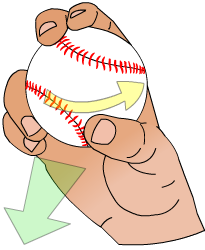
In baseball, a slider is a breaking ball pitch that tails laterally and down through the batter's hitting zone; it is thrown with less speed than a fastball but greater than the pitcher's curveball.

In baseball and softball, the curveball is a type of pitch thrown with a characteristic grip and hand movement that imparts forward spin to the ball, causing it to dive as it approaches the plate. Varieties of curveball include the 12–6 curveball, power curveball, and the knuckle curve. Its close relatives are the slider and the slurve. The "curve" of the ball varies from pitcher to pitcher.

A split-finger fastball or splitter is an off-speed pitch in baseball that looks to the batter like a fastball until it drops suddenly. Derived from the forkball, it is so named because the pitcher puts the index and middle finger on different sides of the ball.

In baseball, a starting pitcher or starter is the first pitcher in the game for each team. A pitcher is credited with a game started if they throw the first pitch to the opponent's first batter of a game. Starting pitchers are expected to pitch for a significant portion of the game, although their ability to do this depends on many factors, including effectiveness, stamina, health, and strategy.

In baseball, a pitch is the act of throwing a baseball toward home plate to start a play. The term comes from the Knickerbocker Rules. Originally, the ball had to be literally "pitched" underhand, as with pitching horseshoes. Overhand throwing was not allowed until 1884.

In baseball, a cut fastball or cutter is a type of fastball that breaks toward the pitcher's glove-hand side, as it reaches home plate. This pitch is somewhere between a slider and a four-seam fastball, as it is usually thrown faster than a slider but with more movement than a typical fastball. Some pitchers use a cutter to prevent hitters from expecting their regular fastballs. A common technique for throwing a cutter is to use a four-seam fastball grip with the baseball set slightly off center in the hand. A batter hitting a cutter pitch often achieves only soft contact and an easy out due to the pitch's movement keeping the ball away from the bat's sweet spot. The cutter is typically 2–5 mph slower than a pitcher's four-seam fastball. In 2010, the average pitch classified as a cutter by PITCHf/x thrown by a right-handed pitcher was 88.6 mph; the average two-seamer was 90.97 mph.
In baseball, an off-speed pitch is a pitch thrown at a slower speed than a fastball. Breaking balls and changeups are the two most common types of off-speed pitches. Very slow pitches which require the batter to provide most of the power on contact through bat speed are known as "junk" and include the knuckleball and the Eephus pitch, a sort of extreme changeup. The specific goals of off-speed pitches may vary, but in general they are used to disrupt the batter's timing, thereby lessening his chances of hitting the ball solidly or at all. Virtually all professional pitchers have at least one off-speed pitch in their repertoire. Despite the fact that most of these pitches break in some way, batters are sometimes able to anticipate them due to hints that the pitcher gives, such as changes in arm angle, arm speed, or placement of fingers.
A gyroball is a type of baseball pitch used primarily by players in Japan. It is thrown with a spiral-like spin, so that there is no Magnus force on the ball as it arrives at home plate. The gyroball is sometimes confused with the shuuto, another pitch used in Japan.
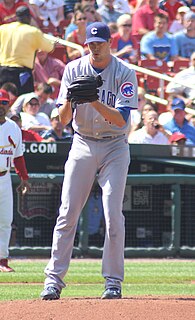
Sean Christopher Marshall, nicknamed "Big Smooth", is an American former professional baseball pitcher. He played in Major League Baseball (MLB) for the Chicago Cubs and Cincinnati Reds.

Glen Weston Perkins is an American former professional baseball pitcher. He played his entire career in Major League Baseball (MLB) for the Minnesota Twins.
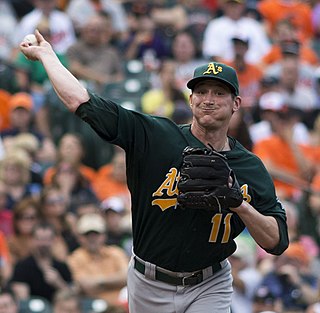
Jarrod Parker is an American former professional baseball pitcher. He was drafted by the Arizona Diamondbacks as the 9th overall pick in the 2007 Major League Baseball Draft from Norwell High School in Ossian, Indiana. He played in Major League Baseball (MLB) for the Diamondbacks and the Oakland Athletics.

Kevin Martin Jepsen is an American former professional baseball pitcher. He played in Major League Baseball (MLB) for the Los Angeles Angels of Anaheim, Tampa Bay Rays, Minnesota Twins, and Texas Rangers.

Albertín Aroldis Chapman de la Cruz is a Cuban-American professional baseball pitcher for the New York Yankees of Major League Baseball (MLB). He previously played in MLB for the Cincinnati Reds and Chicago Cubs and in the Cuban National Series for Holguín. Chapman bats and throws left-handed, and is nicknamed the "Cuban Missile" or the "Cuban Flame Thrower". Chapman pitched for Holguín domestically and internationally for the Cuban national baseball team. He defected from Cuba in 2009 and signed a contract with the Reds in 2010. Chapman made his MLB debut that season. He won the MLB Delivery Man of the Month Award as the best relief pitcher for July 2012, was named to four straight National League All-Star teams from 2012 to 2015. The Reds traded Chapman to the Yankees after the 2015 season, and the Yankees traded Chapman to the Cubs during the 2016 season. With the Cubs, Chapman won Game 7 of the 2016 World Series. He signed with the Yankees after the 2016 season.

Kelvin de Jesús Herrera Mercado is a Dominican former professional baseball pitcher. He played in Major League Baseball (MLB) for the Kansas City Royals from 2011 to 2018, Washington Nationals in 2018, and Chicago White Sox in 2019 and 2020. Herrera is a two-time MLB All-Star.
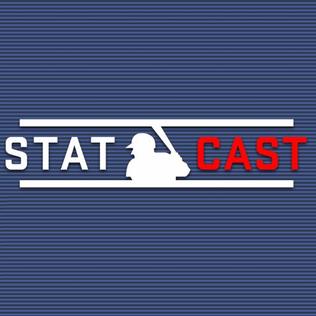
Statcast is a high-speed, high-accuracy, automated tool developed to analyze player movements and athletic abilities in Major League Baseball (MLB). Statcast was introduced to all thirty MLB stadiums in 2015.
Pitch quantification is the attempt to describe the quality of a pitch using a single numeric value based on quantifiable aspects of an individual baseball pitch. There are two main kinds of pitch quantification. The first is outcome oriented. This means that the result of a given pitch is a component used to calculate the overall numeric value that describes the quality of the pitch. The other kind of pitch quantification does not consider the outcome of a pitch when calculating quality. Rather, it is batter independent. Its quality can be assessed without regard to what the batter does with the pitch.
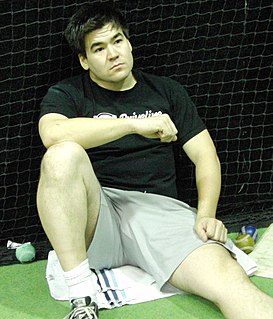
Kyle Boddy is an American baseball pitching trainer and consultant. He is the founder and owner of baseball performance training system Driveline Baseball, which uses a sabermetric approach to increase pitching velocity and improve conditioning. He is also employed by the Cincinnati Reds of Major League Baseball.
References
- ↑ DiMeo, Nate (August 15, 2007). "Pitch f/x, the new technology that will change baseball analysis forever. - Slate Magazine". Slate . Retrieved 18 October 2012.
- ↑ Nathan, Alan M. (February 29, 2012). "Analysis of knuckleball trajectories". Procedia Engineering. 34: 116–121. doi: 10.1016/j.proeng.2012.04.021 .
- ↑ Newman, Mark (October 2, 2007). "Pitch-f/x adds insight to watching games". MLB.com . Retrieved 13 January 2014.
- ↑ Allen, Dave (March 5, 2010). "How Can I Get My Hands on the Pitchf/x Data?". Baseball Analysts. Retrieved 1 October 2012.
- ↑ Nathan, Alan M. (October 18, 2012). "Determining Pitch Movement from PITCHf/x Data" (PDF). Retrieved 18 October 2012.[ permanent dead link ]
- ↑ Fast, Mike (June 17, 2010). "The Internet cried a little when you wrote that on it". The Hardball Times. Retrieved 18 October 2012.
- ↑ Brooks, Dan (February 3, 2012). "Yes, we actually classified every pitch". The Hardball Times. Retrieved 31 October 2012.
- ↑ "Did any pitchers actually throw harder on Opening Day?". Pinstripe Alley (SB Nation). Vox Media. Retrieved 7 April 2017.
- ↑ "Estimating Release Point Using Gameday's New Start_Speed". Baseball Prospectus. Retrieved 7 April 2017.